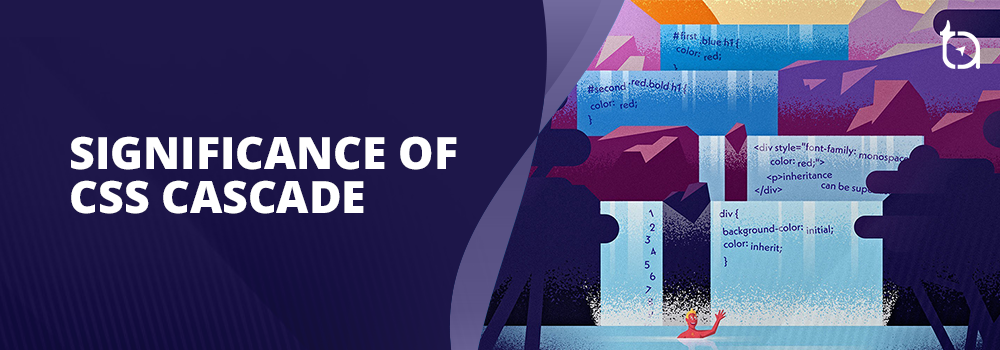The Role of CSS Cascade in Helping Browsers Navigate Conflicting CSS Styles

Author : Abishek Surya RS 22nd Apr 2020

Any website that you visit gets its styling because of Cascading Style Sheets (CSS). The plain HTMLHTMLHypertext Markup Language is the standard markup language for documents designed to be displayed in a web browser. It can be assisted by technologies such as Cascading Style Sheets and scripting languages such as JavaScript. pages along with the CSSCSSCascading Style Sheets is a style sheet language used for describing the presentation of a document written in a markup language like HTML. CSS is a cornerstone technology of the World Wide Web, alongside HTML and JavaScript.give front-end developers options to customize the websites according to the needs and requirements. One of the powerful parts of CSS is the CSS Cascade. It is powerful and needs to be understood in the right way.
What is CSS Cascade?
When there are many elements in a web page, it is natural for you to expect conflicts in the way CSS properties are placed. CSS properties end up competing with one another in where they need to appear in the cascade hierarchy. To resolve such conflicts, you have CSS Cascade.
The CSS Cascade is a way for browsers to resolve conflicting CSS declarations. By specifying CSS rules, you specify where the CSS style is added to the cascade hierarchy. The further down a hierarchy a declaration falls, the less likely it will end up as the final style.
The 4 Different Tiers
The following are 4 tiers of the CSS Cascade which determine the various rules and deal with the CSS conflicts. These tiers are explained in detail in the subsequent sections.
- Importance
- Origin
- Specificity
- Position
First Tier – Importance
This is based on the type of rule and decides the cascading order based on this factor. There are four types of rules. This top tier is meant for elements to ensure smooth animation and developers who require help.
1. Transition
Covering all those rules which involve active transitions, these rules take top priority.
2. !important
You add this to a declaration only when you need to override some style from third-party libraries. This is added to the end of a declaration and tells the browser to push this CSS declaration rules up the cascade.
3. Animation
When you have any active animation rule, it goes a level up in the CSS cascade.
4. Normal
CSS Cascade accommodates most of the rules at this level.
In case, there is a tie between two rules in one tier of the cascade, you can then move on to another tier, until there is a clear difference in one of the subsequent tiers.
Second Tier – Origin
This tier is based on where the rule was defined. There are three places where this is possible –
1. Website
This is where, as a web developer, you have some control over the CSS style.
2. User
This is set and controlled by the user of the web browser. In general, people do not add one, but if such CSSCSSCascading Style Sheets is a style sheet language used for describing the presentation of a document written in a markup language like HTML. CSS is a cornerstone technology of the World Wide Web, alongside HTML and JavaScript. rules are added to websites, it is done for adding accessibility and overriding styles.
3. Browser
Every browser comes with its unique set of styles, and so HTML tags like <buttons> come with default browser styles.
One difference between the first tier and second tier is that here “ !important “ gives Browser rules higher priority than a Website. This is the reverse of the First tier because normally Website rules get higher priority than a Browser.
Third Tier – Specificity
Specificity is the means by which browsers decide which CSS property values are the most relevant to an element and, therefore, will be applied. The third tier uses this specificity when looking at a rule.
1. inline
There are selectors which determine the CSS styles to which the set of CSS rules apply. As we create CSS rules, you can use them to target elements that need to be subjected to some change.
As a rule, the elements which are declared within a <style> property are the most specific and are known as inline elements.
2. id
To target an element with id, you can use the syntax #id.
3. class / attribute / pseudo – class
To target an element with class, you can use the syntax “.class”. You can also target using attribute selectors like [checked] and pseudo-selectors like “:first-of-type”.
4. type / pseudo – element
You can target elements based on their tag type, using syntax “type”. You can also use pseudo-elements like “:before” to do this.
When there is a tie between two rules in this tier of the Cascade, the rule which has a higher number of hits on the highest reached-level will be given priority.
Also, if there is an equal number of hits in one tier, the rule which has a hit on the subsequent level is chosen.
Fourth Tier – Position
The last tier looks at the order in which the rules were originally defined. Here, the rules that are defined in stylesheet or <style> tags are given precedence, with all other factors remaining the same.
Wrapping Up
This is how CSS Cascade helps in dealing with conflicting CSS styles and makes it easier for browsers to deal with CSS styles. At TechAffinity, our expert front-end developers are known for designing websites very quickly and professionally. If you have further queries, feel free to mail us at media@techaffinity.com or you can schedule a meeting.
